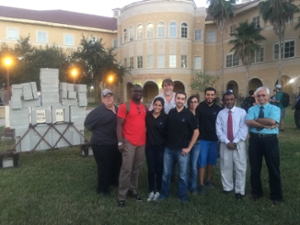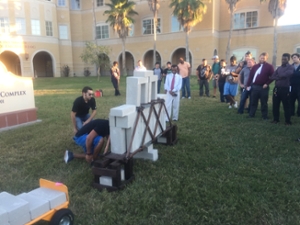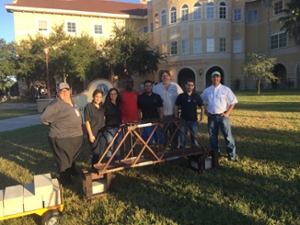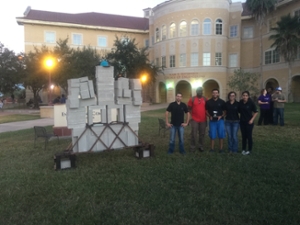Student Team Takes First Place in Engineering Preservation Competition


A group of civil and architectural engineering students from Texas A&M University-Kingsville took first place at the inaugural Student Preservation Construction Competition, sponsored by the Association for Preservation Technology International (APTI).
The competition was part of the APTI annual conference, held in San Antonio.
The competition was in two parts. The first part involved designing and constructing a six-foot timber bridge, using the technology and materials available in 1906. The second part of the competition involved solving two preservation problems, using the preservation professionals at the conference as consultants, in an effort to foster student-professional engagement.
The team represented A&M-Kingsville’s Institute of Architectural Engineering Heritage. The students worked under Institute director and assistant professor Jim Glusing, and were mentored by A&M-Kingsville civil engineering professor Dr. Francisco Aguiniga and Patrick Sparks, P.E., of Sparks Engineering. The Celanese Bishop facility and the Frank H. Dotterweich and June Smith Dotterweich Memorial Trust sponsored conference attendance for the team, and McCoy’s Building Supply provided the tools and materials used.
“It provided our students with a unique opportunity for practical application of their structural engineering skills,” Glusing said. “I am still impressed by the elegance and strength of their design.”
Student team contributors included Brandon Darr, senior, architectural engineering;
Sara Cantu Williams, junior, architectural engineering; Santiago Vargas, senior, civil engineering; Ajibola Alamutu, graduate student, civil engineering; and Beatriz Alba, senior, architectural engineering.
Alba called the design and construction of the timber bridge the most rewarding experience she has ever had. “Everyone helped each other. We shared knowledge that we have been accumulating throughout our college career about structural design. We implemented this knowledge and we got hands-on experience building the bridge. Our relationship as classmates evolved into a solid friendship, which let us work as a proficient team that shared a common goal,” Alba said.
“Our mentor, Patrick Sparks, and our advisors, James Glusing and Dr. Francisco Aguiñiga, changed the perspective of ‘competition’ into a significant learning experience. It was never about winning the competition. It was about performing the best we could in the competition,” Alba noted.
The panel of judges included preservation professionals from the United States, Canada and Europe.
The Texas A&M-Kingsville team was one of a select few universities asked to participate in this initial contest. The team offered their input on competition guidelines during the summer, then spent eight weeks building their timber bridge.
The participating teams had to disassemble their bridge, bring it to the competition, and reassemble it while being timed. The timber bridge was then load tested with 500 pounds of weight.
For the second part of the competition, the teams were given a day to develop a plan to repair and restore a damaged bridge built in 1906. They were also asked to research how to modernize the bridge for automobile traffic, while maintaining the historic authenticity and fabric of the bridge.
The team’s winning timber bridge design was load tested publicly Wednesday, Nov. 16 outside the A&M-Kingsville Javelina Engineering Complex for faculty, students and administrators of the Frank H. Dotterweich College of Engineering. The timber bridge held a pallet of cinderblocks weighing more than 2,400 pounds without breaking.


